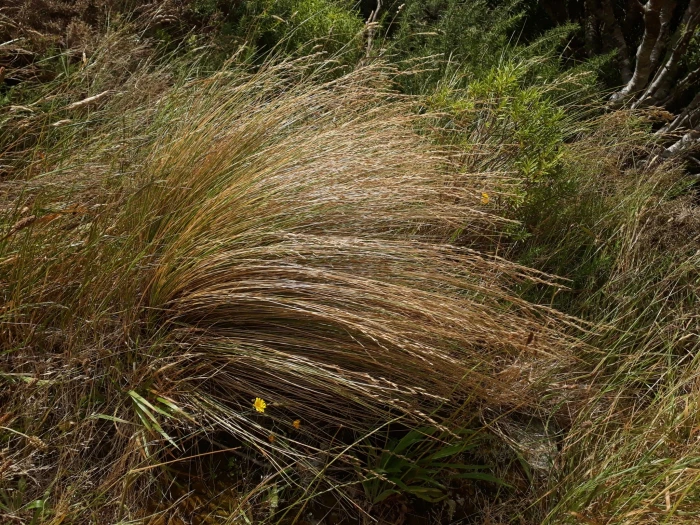Silver Tussock
(Poa cita)
Silver Tussock (Poa cita)
/
/

Leon Perrie
CC BY 4.0
Image By:
Leon Perrie
Recorded By:
Copyright:
CC BY 4.0
Copyright Notice:
Photo by: Leon Perrie | License Type: CC BY 4.0 | License URL: http://creativecommons.org/licenses/by/4.0/ | Rights Holder: Leon Perrie | Publisher: iNaturalist | Date Created: 2019-01-06T13:24:54-08:00 |



















































Estimated Native Range
Climate Requirements for Sumter, South Carolina
| This Plant | Your Site | Plant Suitability for Your Location | ||
|---|---|---|---|---|
| • Precipitation | 21" - 178" | 47" | Aquatic | Aquatic |
| • High Temp. | 59°F - 77°F | 92°F | Your summers may be too hot for this plant. | Too hot |
| • Low Temp. | 19°F - 48°F | 33°F | Your winter temperatures are normal for this plant | Excellent |
This plant should grow very well at your location but requires an aquatic environment.
Summary
Poa cita, commonly known as Silver Tussock, is an evergreen perennial grass native to the tussock grasslands, alpine regions, and subalpine scrublands of New Zealand. It can grow to heights of 0.3–1.0 meters and, in its natural habitat, is often found draping down steep banks with lengths reaching up to 2 meters. The foliage of Silver Tussock is distinctive, with very fine, narrow leaves that are typically 1–1.5 millimeters wide, though they can reach up to 2.5 millimeters. The leaf width is variable and can range from needle-like to relatively wide, depending on the specific growing conditions within its native range.
Silver Tussock is valued for its fine-textured foliage that provides a silver-gray accent in garden designs. It is often used in rock gardens, as a ground cover, and in mass plantings for erosion control on slopes. This grass is appreciated for its low maintenance requirements and its ability to thrive in poor soils. It prefers full sun but can tolerate partial shade and requires low to medium amounts of water once established, making it suitable for xeriscaping. While generally disease-free, it can suffer from root rot in poorly drained soils.CC BY-SA 4.0
Silver Tussock is valued for its fine-textured foliage that provides a silver-gray accent in garden designs. It is often used in rock gardens, as a ground cover, and in mass plantings for erosion control on slopes. This grass is appreciated for its low maintenance requirements and its ability to thrive in poor soils. It prefers full sun but can tolerate partial shade and requires low to medium amounts of water once established, making it suitable for xeriscaping. While generally disease-free, it can suffer from root rot in poorly drained soils.CC BY-SA 4.0
Plant Description
- Plant Type: Grass
- Height: 1-2.5 feet
- Width: 1-2 feet
- Growth Rate: Moderate
- Flower Color: N/A
- Flowering Season: Spring
- Leaf Retention: Evergreen
Growth Requirements
- Sun: Full Sun
- Water: Low, Medium
- Drainage: Medium
Common Uses
Butterfly Garden, Low Maintenance
Natural Habitat
Native to tussock grasslands, alpine regions, and subalpine scrublands of New Zealand
Other Names
Common Names: Blue Tussock, Wī, Silvergröe
Scientific Names: Poa cita, Poa caespitosa, Poa caespitosa var. leioclada, Poa caespitosa var. planifolia, Poa laevis var. filifolia
GBIF Accepted Name: Poa cita Edgar